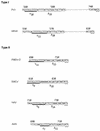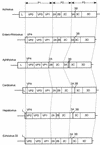Complete nucleotide sequence and genetic organization of Aichi virus, a distinct member of the Picornaviridae associated with acute gastroenteritis in humans
- PMID: 9733894
- PMCID: PMC110230
- DOI: 10.1128/JVI.72.10.8408-8412.1998
Complete nucleotide sequence and genetic organization of Aichi virus, a distinct member of the Picornaviridae associated with acute gastroenteritis in humans
Abstract
The complete nucleotide sequence of a novel enteric virus, Aichi virus, associated with nonbacterial acute gastroenteritis in humans was determined. The Aichi virus genome proved to be a single-stranded positive-sense RNA molecule with 8,251 bases excluding a poly(A) tail; it contains a large open reading frame with 7,302 nucleotides that encodes a potential polyprotein precursor of 2,433 amino acids. The genome contains a 5' nontranslated region (NTR) with 712 bases and a 3' NTR with 240 bases followed by a poly(A) tail. The structure of the genome, VPg-5' NTR-leader protein-structural proteins-nonstructural proteins-3' NTR-poly(A), was found to be typical of a picornavirus. The VP0-VP3 and VP3-VP1 cleavage sites were determined to be Q-H and Q-T, respectively, by N-terminal amino acid sequence analyses using purified virion proteins. Possible cleavage sites, Q-G, Q-A, and Q-S, which cleave P2 and P3 polyproteins were found to be similar to those of picornaviruses. A dendrogram based on 3Dpol proteins indicated that Aichi virus is genetically distinct from the known six genera of picornaviruses including entero-, rhino-, cardio-, aphtho-, and hepatovirus and echovirus 22. Considering this together with other properties of the virus (T. Yamashita, S. Kobayashi, K. Sakae, S. Nakata, S. Chiba, Y. Ishihara, and S. Isomura, J. Infect. Dis. 164:954-957, 1991), we propose that Aichi virus be regarded as a new genus of the family Picornaviridae.
Figures




Similar articles
-
A distinct picornavirus group identified by sequence analysis.Proc Natl Acad Sci U S A. 1992 Sep 15;89(18):8847-51. doi: 10.1073/pnas.89.18.8847. Proc Natl Acad Sci U S A. 1992. PMID: 1528901 Free PMC article.
-
Complete nucleotide and amino acid sequences and genetic organization of porcine kobuvirus, a member of a new species in the genus Kobuvirus, family Picornaviridae.Arch Virol. 2009;154(1):101-8. doi: 10.1007/s00705-008-0288-2. Epub 2008 Dec 19. Arch Virol. 2009. PMID: 19096904
-
Identification and genetic characterization of a novel picornavirus from chickens.J Gen Virol. 2014 May;95(Pt 5):1094-1103. doi: 10.1099/vir.0.061085-0. Epub 2014 Feb 4. J Gen Virol. 2014. PMID: 24496829
-
[Biological and epidemiological characteristics of Aichi virus, as a new member of Picornaviridae].Uirusu. 1999 Dec;49(2):183-91. doi: 10.2222/jsv.49.183. Uirusu. 1999. PMID: 10737116 Review. Japanese. No abstract available.
-
A Comprehensive Review on Human Aichi Virus.Virol Sin. 2020 Oct;35(5):501-516. doi: 10.1007/s12250-020-00222-5. Epub 2020 Apr 27. Virol Sin. 2020. PMID: 32342286 Free PMC article. Review.
Cited by
-
Construction of an infectious cDNA clone of Aichi virus (a new member of the family Picornaviridae) and mutational analysis of a stem-loop structure at the 5' end of the genome.J Virol. 2001 Sep;75(17):8021-30. doi: 10.1128/jvi.75.17.8021-8030.2001. J Virol. 2001. PMID: 11483747 Free PMC article.
-
The 5'-terminal region of the Aichi virus genome encodes cis-acting replication elements required for positive- and negative-strand RNA synthesis.J Virol. 2005 Jun;79(11):6918-31. doi: 10.1128/JVI.79.11.6918-6931.2005. J Virol. 2005. PMID: 15890931 Free PMC article.
-
Characterization of a canine homolog of human Aichivirus.J Virol. 2011 Nov;85(21):11520-5. doi: 10.1128/JVI.05317-11. Epub 2011 Aug 31. J Virol. 2011. PMID: 21880761 Free PMC article.
-
Viruses in diarrhoeic dogs include novel kobuviruses and sapoviruses.J Gen Virol. 2011 Nov;92(Pt 11):2534-2541. doi: 10.1099/vir.0.034611-0. Epub 2011 Jul 20. J Gen Virol. 2011. PMID: 21775584 Free PMC article.
-
Candidate porcine Kobuvirus, China.Emerg Infect Dis. 2009 May;15(5):823-5. doi: 10.3201/eid1505.081518. Emerg Infect Dis. 2009. PMID: 19402982 Free PMC article. No abstract available.
References
-
- Ando T, Mulders M N, Lewis D C, Estes M K, Monroe S S, Glass R I. Comparison of the polymerase region of small round structured virus strains previously classified in three antigenic types by solid-phase immune electron microscopy. Arch Virol. 1994;135:217–226. - PubMed
-
- Auvinen P, Hyypiä T. Echoviruses include genetically distinct serotypes. J Gen Virol. 1990;71:2133–2139. - PubMed
-
- Blacklow N R. Medical virology of small round gastroenteritis viruses. In: de la Maza L M, Peterson E M, editors. Medical virology, no. 9. New York, N.Y: Plenum Press; 1990. pp. 111–128.
MeSH terms
Substances
Associated data
- Actions
LinkOut - more resources
Full Text Sources
Medical

